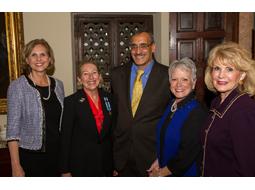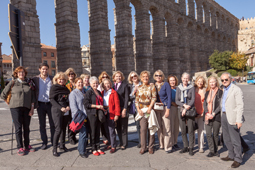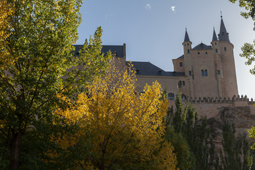Units Overseas Tour: Spain

We departed our London hotel before dawn for an early flight to Madrid on October 17, 2014. En route to the airport, we were startled to see the blue lights of the London Eye against the darkness of the sky in the background. This large “ferris wheel” is said to be the number one tourist attraction in Great Britain, offering panoramic views all the way to Windsor Castle from the top. It’s too bad we did not have time for a ride!
After a short flight, we are met at the Madrid airport by Maureen Gafford Vidal, España Chapter Regent, Molly Long Fernandez, Chapter Corresponding Secretary, and Molly’s sister, Anthony Startz, an associate member and a friend of mine from Houston who chairs the Texas Spanish Task Force. After checking into the Hotel Wellington, we were escorted to the home of the Deputy Chief of Mission (DCM) for the American Embassy, Krishner Urs. In the absence of the American Ambassador, Mr. Urs received the NSDAR delegation and España chapter members, spouses and guests. A reception was hosted by the chapter in this historic palace filled with antique Spanish furniture and paintings which serves as the home of the Deputy Chief of Mission. Mr. Urs, Maureen and I received guests in the foyer adjacent to the formal reception rooms of the palace. It was a pleasure to greet Tomas Poveda, Director of Casa de America who had visited our Headquarters last fall. Maureen presented Mr. Urs with a necktie featuring the signatures of the signers of the Declaration of Independence which he wore for the remainder of the afternoon. Mr. Urs expressed greetings and gave a short talk on the history of the Palace and the furnishings.
We returned to our hotel to change for the evening visit, where we were escorted to the Madrid Council of the United States Navy League Anniversary Ball by Maureen and her husband, Juan Vidal. This formal event celebrated the 239th anniversary of the United States Navy which was founded October 13, 1775. Molly Fernandez, League President, presided over the assembly of Spanish and U.S. Military and Defense contractors, spouses and guests. The Madrid Council of the Navy League is a non-profit organization whose sole purpose is to support the aims and purposes of the Navy League of the United States particularly as they relate to the maintenance of a strong NATO alliance. During the evening, we were welcomed to Spain by the Spanish Chief of Naval Operations, Admiral General Jaime Munoz Delgado, and attachés of the United States Embassy, Air Force Colonel Robert Davis and Navy Commander Thomas Poulter. My husband and I were honored to be seated with the immediate Past President of the Navy League, and member of the Sons of the American Revolution, Nicholas Hayes, and his wife, Sheila Donavan. Following a delicious meal of Spanish cuisine, including gazpacho and baked hake, the official meeting concluded and the dancing began. We were honored to be guests of Molly and her husband at this prestigious event and to have the opportunity to represent NSDAR in a multi-cultural setting and join with others who share the ideals of promoting world peace and security as guaranteed by the naval forces of the U.S. and the Spanish State.
On Saturday morning, we were met at the hotel by 18 of the chapter’s 36 members for a bus ride to the ancient town of Segovia, about an hour from Madrid. This was my first trip to Spain and I enjoyed learning about Spanish history from Maureen while viewing the lovely countryside.
 According to legend, Segovia was founded around 1076 BC, by the great-grandson of Noah, Hercules Egipcio. It was settled successively by Iberians, Arevacos, Vacceos, Celts, Romans and Moors. The enormous Roman aqueduct is the most important Roman artifact in Spain, built by the early years of the second century. The structure contains no mortar; therefore it has stood securely for 2,000 years. We were greeted at the aqueduct by our hosts, member Kala Harvey, her husband José de Rivas and their son Andrew, an architect. Andrew graduated from Cornell University and taught architecture at Syracuse University. He gave us a fabulous tour along the cobblestone streets and not only pointed out the many historically significant buildings, but also pointed out the architectural elements which indicated the periods in which the buildings were erected. The buildings often had Romanesque arches on the lower floor with Moorish geometric patterns on the second level made from plaster. The town has a castle, a cathedral and 14 Romanesque churches. Unfortunately, time did not permit us to visit each one.
According to legend, Segovia was founded around 1076 BC, by the great-grandson of Noah, Hercules Egipcio. It was settled successively by Iberians, Arevacos, Vacceos, Celts, Romans and Moors. The enormous Roman aqueduct is the most important Roman artifact in Spain, built by the early years of the second century. The structure contains no mortar; therefore it has stood securely for 2,000 years. We were greeted at the aqueduct by our hosts, member Kala Harvey, her husband José de Rivas and their son Andrew, an architect. Andrew graduated from Cornell University and taught architecture at Syracuse University. He gave us a fabulous tour along the cobblestone streets and not only pointed out the many historically significant buildings, but also pointed out the architectural elements which indicated the periods in which the buildings were erected. The buildings often had Romanesque arches on the lower floor with Moorish geometric patterns on the second level made from plaster. The town has a castle, a cathedral and 14 Romanesque churches. Unfortunately, time did not permit us to visit each one.
 In the Plaza Mayor, we learned that Isabella was crowned Queen in 1474 in the nearby Church of San Miquel. Deputy Mayor Javier Giraldez welcomed us to his beautiful residence. The ceiling in Sala Blanca (White Hall) is decorated with a fresco of the conquest of Madrid and defeat of the Moors. Mayor Giraldez presented each of us with a lapel pin depicting the aqueduct and gave me a pictorial book of Segovia. Afterwards, he joined us on the balcony for a group photo.
In the Plaza Mayor, we learned that Isabella was crowned Queen in 1474 in the nearby Church of San Miquel. Deputy Mayor Javier Giraldez welcomed us to his beautiful residence. The ceiling in Sala Blanca (White Hall) is decorated with a fresco of the conquest of Madrid and defeat of the Moors. Mayor Giraldez presented each of us with a lapel pin depicting the aqueduct and gave me a pictorial book of Segovia. Afterwards, he joined us on the balcony for a group photo.
We walked to the Alcázar Castle (which means “Defensive Palace”), said to have been the one on which Walt Disney designed the Disney World castle. Built upon the remains of proto-Gothic elements and Romanesque windows, the impressive structure has been damaged by fire more than once and rebuilt. We had goose bumps standing before the throne on which Queen Isabella gave Christopher Columbus approval to seek the New World. Segovian artist Carlos Muñoz de Pablos welcomed us to the Galley Room, in which a mural he painted of the coronation of Queen Isabella is displayed. We were interested to hear that he used descendants of the witnesses to the coronation as models in his painting.
 From the castle, we walked downhill to the home of Kala Harvey and her husband, Jose de Rivas. Their home is situated on the other side of the river with a magnificent view of the ancient town. We enjoyed tapas on their patio and then had a wonderful Spanish luncheon of gazpacho, paella and ponche segoviano for dessert. Ponche segoviano is a traditional dessert in Segovia, made from eggs, almonds, sugar and marzipan. Excellente! Next to the home is an 8th century monastery, one of eight remaining Jeromite monasteries in the world. The monastery was built in the 1400s and still has Friars in residence.
From the castle, we walked downhill to the home of Kala Harvey and her husband, Jose de Rivas. Their home is situated on the other side of the river with a magnificent view of the ancient town. We enjoyed tapas on their patio and then had a wonderful Spanish luncheon of gazpacho, paella and ponche segoviano for dessert. Ponche segoviano is a traditional dessert in Segovia, made from eggs, almonds, sugar and marzipan. Excellente! Next to the home is an 8th century monastery, one of eight remaining Jeromite monasteries in the world. The monastery was built in the 1400s and still has Friars in residence.
We walked further along the riverbank to the Church of Vera Cruz, constructed by the Knights Templar in 1208. This church is believed to be one of the original Knights Templar churches based on the similarity of the design to the Holy Sepulchre in Jerusalem. When the Pope decreed the Knights Templar must be dissolved in the 1500s, it passed on to the Knights of Malta. The ground floor is a twelve-sided polygonal building with remnants of the original frescoes still visible.
 Sunday morning Maureen met us at the hotel for a short walk to Case de America, a public institution with the purpose of strengthening bonds between Spain and the Americas. Director Tomas Poveda arranged for us to visit the plaque placed by the DAR during the Wagoner administration in 2006 which commemorates Spanish aid to the Independence of the United States of America. Afterwards we walked to the nearby Museum to see a large portrait of George Washington where we were joined by Molly Long, Anthony Startz, and Registrar Pat Rios. The portrait was commissioned in 1796 to commemorate the Treaty of Friendship between Spain and the U.S. Virginia, Maureen and I stopped for a delicious lunch at a nearby department store before returning to the hotel to begin packing for our departure Monday morning.
Sunday morning Maureen met us at the hotel for a short walk to Case de America, a public institution with the purpose of strengthening bonds between Spain and the Americas. Director Tomas Poveda arranged for us to visit the plaque placed by the DAR during the Wagoner administration in 2006 which commemorates Spanish aid to the Independence of the United States of America. Afterwards we walked to the nearby Museum to see a large portrait of George Washington where we were joined by Molly Long, Anthony Startz, and Registrar Pat Rios. The portrait was commissioned in 1796 to commemorate the Treaty of Friendship between Spain and the U.S. Virginia, Maureen and I stopped for a delicious lunch at a nearby department store before returning to the hotel to begin packing for our departure Monday morning.
 The Chapter’s meeting was held Sunday evening in St. Georges Anglican Church, attended by more than half of the 36 members, including two that had ridden 3 hours on a high speed train from Seville. The Chapter Chaplain, Ellie Harris, recently moved to Arizona but still participates by emailing prayers. It was an honor to install three new members and to hear of their four prospective members. I was thrilled to receive a generous check for the President General’s Project and a replica of a 1770s map of Spanish Texas, showing the missions which were located across the river from our ranch. Steve is as excited about the map as I am and we look forward to hanging it at the ranch. Virginia and Mindy were both invited to address the chapter and certificates of appreciation were given to several members for their outstanding efforts in supporting the Units Overseas. I enjoyed learning that the Chapter has adopted the Spanish I and II classes at Kate Duncan Smith DAR School and frequently sends postcards of scenes from Spain.
The Chapter’s meeting was held Sunday evening in St. Georges Anglican Church, attended by more than half of the 36 members, including two that had ridden 3 hours on a high speed train from Seville. The Chapter Chaplain, Ellie Harris, recently moved to Arizona but still participates by emailing prayers. It was an honor to install three new members and to hear of their four prospective members. I was thrilled to receive a generous check for the President General’s Project and a replica of a 1770s map of Spanish Texas, showing the missions which were located across the river from our ranch. Steve is as excited about the map as I am and we look forward to hanging it at the ranch. Virginia and Mindy were both invited to address the chapter and certificates of appreciation were given to several members for their outstanding efforts in supporting the Units Overseas. I enjoyed learning that the Chapter has adopted the Spanish I and II classes at Kate Duncan Smith DAR School and frequently sends postcards of scenes from Spain.
The España Chapter was organized February 3, 2001 with 10 members and they almost quadrupled in size in 13 years. Several members have worked hard researching and documenting the role of Spaniards and the Spanish Crown in the American Revolution. The ladies were excited to hear that NSDAR recently authorized funds to retain a researcher to copy the Donativo records in the Mexico City archives.
New member Jeannie West had compiled a marvelous directory of the chapter members complete with color photographs. Historian Kristine L. Sjostrom is writing a book on Fernando de Lebya and gave an excellent presentation on his importance in the battle of San Carlos and the impact on the American War for Independence.
The large Naval base at Rota is preparing to welcome four American destroyers and the chapter has placed an ad in the local newspaper encouraging newly arrived Americans to join the DAR.
A lovely reception was held in the parish hall where all enjoyed refreshments and visiting. The members have established a close bond and a sisterhood, one of the advantages I most appreciate with being a member of the DAR. Kala’s husband, Jose, arrived with a box of ponche which reminded us of our visit to Segovia.
We reluctantly bid Adios to our Spanish friends and walked back to our hotel for an early morning departure for Rome, our next stop on the European Adventure!


 Today's DAR
Today's DAR